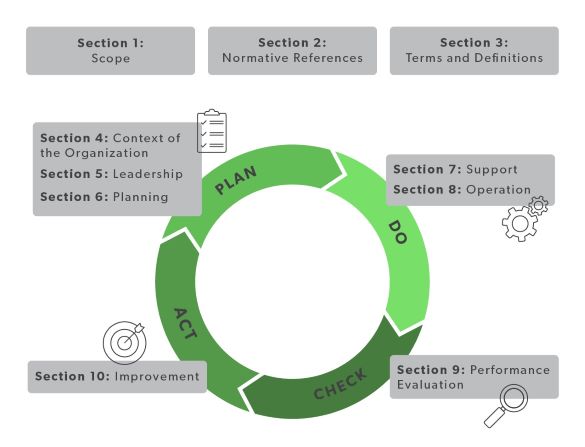What are the ISO 9001 Standards?
What Does ISO Stand for?
ISO stands for the International Organization for Standardization. ISO is an international agency comprised of the national standards bodies of more than 160 countries.
What is ISO 9001?
ISO 9001 is defined as the international standard that specifies requirements for a quality management system (QMS). ISO Standards make the world a cleaner, safer and more efficient place to live. The ISO 9001 Standards are international requirements that organizations use to demonstrate the ability to provide products and services that meet regulatory and statutory requirements so that we can continue to live in a world that is safe, clean and efficient. Any type of business in any country can become ISO 9001 certified anywhere in the world.
ISO 9001 Standard
The ISO 9001 Standard is the most popular standard in the ISO 9000 series and the only standard in the 9000 series that organizations can certify. The current ISO 9001 version was released in September 2015.
Get a Free Quote
The requirements of ISO 9001 will guide you through the process approach with the use of the Plan-Do-Check-Act Cycle and reveal risks and opportunities for improvement to your leadership team. This will help to improve the quality management system within your business and as a natural consequence, improve many other aspects of your company. Read more below about the specifics of ISO 9001 Standards, the benefits of getting ISO 9001 certified, and a breakdown of the 7 ISO 9001 requirements that are auditable.
ISO 9001 (sometimes referred to as the ISO 9000 family of quality management standards) is the original quality management standard. It’s the world’s most widely recognized quality management system certification. Download our free ISO 9001 pdf guide.
Consulting Support for ISO 9001
Every year, we help hundreds of small businesses achieve ISO 9001 certification. Support for ISO 9001 is available through any of our Consulting Programs
As an American business with a story like yours, we know that time is valuable. Our expert consultants are here to take on the difficult, technical aspects of certification so you can focus on your business. They’ll work with you every step of the way until you’re successfully certified.
Interested? Get a Free Quote.
What are the Benefits of ISO 9001 Certification?
When you pursue ISO 9001 certification with us, you get more than a piece of paper. You get a management system that can transform your business. Companies that achieve ISO 9001:2015 certification commonly see benefits such as:
Improves quality and service
Reduces your costs
Highlights deficiencies
Provides continuous assessment
Showcases continuous improvement
Ensures higher customer satisfaction
Improves customer relationships
Spurs business growth
Encourages new opportunities
Who Needs ISO 9001 Certification?
ISO 9001 can be implemented by any company of any size. Currently there are more than a million organizations certified to the standard world-wide. The standard can streamline operations for any organization seeking company-wide process improvement. ISO 9001 focuses on building a quality management system and delivering the best possible output. Any industry, from manufacturers to service providers, can benefit from this standard.
Why Choose ISO 9001 Certification?
Getting certified gives your business wide-ranging advantages, including increased customer satisfaction and international recognition of your business standards. Certification boosts your business’s reputation and helps clients know they can trust your products’ quality.
Additionally, this renowned certification opens up your business to new markets and helps you define key operating processes as you meet certification standards. This process can ultimately help your entire team make process improvements, reduce operating costs and deliver optimal quality output.
How to Prepare for Certification?
Preparing for ISO certification involves some important steps. You’ll need trusted consultation services to walk you through the requirements, assess your workflow and communication, and help you conduct your required internal audit before the official third-party certification audit.
For true ISO success, all members of the organization should be involved with the implementation of the new QMS.
What is New About the ISO 9001:2015 Version?
Clause 1, Clause 2, and Clause 3 are like the 2008 version of ISO 9001. The changes in 2015 have to do with the last seven clauses. These seven clauses or requirements are arranged in relationship to the Plan-Do-Check-Act cycle. In addition, the 2015 version of ISO 9001 has added more of an emphasis on risk-based thinking.

What is Risked Based Thinking?
Risk-based thinking allows an organization to determine the factors that could cause processes and quality management systems to veer off course from planned outcomes. Risked-based thinking is intended to put into place preventative controls to ward off negative effects and set your organization to be prepared to take advantage of opportunities as they come up.
“Addressing both risks and opportunities establishes a basis for increasing the effectiveness of the quality management system, achieving improved results and preventing negative effects.” (0.3.3)
What are the ISO 9001 Requirements?
An Overview of the ISO 9001 Requirements
Although there are a total of 10 clauses in the ISO 9001:2015 Standards, the first 3 are not auditable. That leaves 7 clauses or sections (4-10) that are auditable. In addition, some sub-clauses have to do with the Plan-Do-Check-Act system. To receive an ISO 9001 Certification, you need to satisfy the requirements of clauses 4 through 10. You will be audited and must pass the audit before you can receive ISO certification.

ISO 9001 was first published in 1987 by the International Organization for Standardization (ISO), an international agency composed of the national standards bodies of more than 160 countries. The current version of ISO 9001 was released in September 2015.
ISO 9001 Clause 4 – Context of the Organization
Context of the Organization, Clause 4, has to do with identifying and assessing both internal and external issues that could affect your management system’s ability to deliver quality management results. Examples of external issues include potential legal concerns, competitive and economic environments, and social issues. These issues can be negative or positive and can be national, local, or International.
Considering internal issues such as values, culture, knowledge and performance of your organization is also a part of understanding the context of your organization.
ISO 9001 Clause 4 – Subclause 4.2 Understanding the Needs and Expectations of Interested Parties
Clause 4.2 can help you uncover opportunities within your organization by identifying who your interested parties are and how the requirements of those interested parties are met as they relate to your quality management system.
ISO 9001 Clause 4 – Subclause 4.3 Determining the Scope of the Quality Management System
In general, Clause 4.3, the scope of your quality management system, describes what your company does and takes into consideration 3 main criteria:
The products and services of your organization
The internal and external issues as referred to in Clause 4.1

The requirements of relevant parties as referred to in 4.2
“The organization shall determine the boundaries and applicability of its quality management system to establish its scope.”
ISO 9001 Clause 4 – Subclause 4.4 Quality Management System and its Processes
“The organization shall establish, implement, maintain, and continually improve a quality management system, including the processes needed and their interactions, by the requirements of this International Standard.
The organization shall determine the processes needed for the quality management system and their application throughout the organization, and shall:
a) determine the inputs required and the outputs expected from these processes;
b) determine the sequence and interaction of these processes;
c) determine and apply the criteria and methods needed to ensure the effective operation and control of these processes;
d) determine the resources needed for these processes and ensure their availability;
e) assign the responsibilities and authorities for these processes;
f) address the risks and opportunities as determined by the requirements of 6.1;
g) evaluate these processes and implement any changes needed to ensure that these processes achieve their intended results;
h) improve the processes and the quality management system.”
ISO 9001 Clause 4 – Subclause 4.4.2 To the extent necessary, the organization shall:
“a) maintain documented information to support the operation of its processes;
b) retain documented information to have confidence that the processes are being carried out as planned.”
ISO 9001 Clause 5 – Leadership
Section 5 of the ISO 9001 Standards includes subsections addressing leadership involvement and that there is a commitment to both the quality management system and to customer focus.
Top management is required to demonstrate leadership and commitment regarding the QMS. They need to make sure that among other things, that the quality policy and objectives are compatible with the business’s strategic direction, the QMS is integrated into the company’s business processes, and the policy is understood and followed.
There are additional requirements including making the policy available to interested parties and being available as documented information.

ISO 9001 Clause 6 – Planning
Planning asks an organization to plan for uncertainties by proactively considering risks and setting up control measures to address these potential risks. Clause 6 also requires an organization to identify objectives that can be used to evaluate, monitor, and track progress and make plans for any changes that may happen in the quality management system.
This section recommends a proactive approach to handling risks, instead of waiting for problems to occur. This proactive approach of planning for risks allows us to avoid negative situations and helps to reduce our liabilities and at the same time, increase the quality of our products or services.
This section isn’t just about avoiding risks, it is also about uncovering opportunities to create better products or services or to improve our management and manufacturing practices.
ISO 9001 Clause 7 – Support
Clause 7 is about the resources you must have in place to help you become more successful as it relates to the quality management system.
Leadership and management are encouraged to determine the right number and quality of resources need to effectively and efficiently run the organization. Organizations need multiple resources including equipment, training, people, infrastructure, communication channels, and the right environment for the integration and operation of these resources.
Clause 7 has subsections covering support resources including but not limited to monitoring and measuring resources, people, communication, competence, organizational knowledge, awareness, and much more. The effectiveness of the support is expected to be evaluated and adjusted accordingly to make sure the organization delivers services and products with high quality and that customer expectations and requirements are met.
In addition, this clause covers requirements for the quality management documentation and includes recommendations for creating and updating documents and control of documented information.
ISO 9001 Clause 8 – Operation
Clause 8 in general is requiring organizations to plan in advance how they will deliver their services or manufacture their products. This requirement takes into consideration the product requirements and any quality objectives that may need to be included, resources and documents that might be important and what type of inspection or assessment activities need to be in place to make sure services and products meet requirements.
Clause 8 also covers manufacturing requirements and includes the concepts of inspection methods, procedures and risk management:

“Ensuring that product and service inspection and testing methods and procedures are defined and documented, along with their respective acceptance criteria;
Ensuring that each specified inspection, test, and monitoring activity is recorded through work orders, tags, tickets, forms, electronic data collection systems, etc.;
Undertaking risk analysis studies of key manufacturing processes and ensuring mitigations arising from risk management are incorporated into key product and or process designs;”
ISO 9001 Clause 8 – Subclauses 8.1 – 8.7
Clause 8.1 – 8.7 includes communications with customers, determining and reviewing requirements for products and services, changes in the requirements for products and services, and the design and development, planning, input, and controls of products and services.
These subclauses also cover the release of products and services and the control of non-performing outputs.
ISO 9001 Clause 9 – Monitoring, Measurement, Analysis, and Evaluation
Clause 9 is all about monitoring and testing the quality management system you have created and it’s about making sure you keep organized documentation surrounding the QMS.
“The organization shall evaluate the performance and effectiveness of the quality management system.”
“The organization shall keep appropriate documented information as evidence of the results.”
Clause 9 asks companies to monitor their customer’s perception of their performance when it comes to meeting their needs and requirements. This can be accomplished with customer surveys or feedback on delivered products or services and include other choices you can use to evaluate your customer’s perception of your performance.
ISO 9001 Clause 9 – Subsection 9.1.3 Analysis and Evaluation
This subsection of Clause 9 asks that you collect, analyze, and evaluate your quality management system including the evaluation of the data collected with the use of trend analysis, statistical techniques, and more. The information gained from these activities will help with making decisions and plans for the future of the company.

The results of the analysis will be used to evaluate things like the conformity of products and services, the performance and effectiveness of the quality management system, and the effectiveness of actions taken to address risks and opportunities, etc.
ISO 9001 Clause 9 – Subsection 9.2.1 and 9.2.2
These clauses are all about auditing. They require your organization to plan internal audits at regular intervals to make sure the information on your QMS conforms to your requirements and the requirements of this international standard. In addition, your organization is required to plan, establish, implement, and maintain an auditing program. Furthermore, you must define the audit criteria, select auditors, perform the audits, and take corrective action if needed. You are also required to retain documented information that proves the implementation of the audit system.
ISO 9001 Clause 9 – Subsection 9.3 Management Review
This subsection is about Management Reviews and requires the management to review the quality management system regularly, at planned intervals to ensure its continuity, suitability, effectiveness, and alignment with the strategic direction of the organization.
ISO 9001 Clause 10 Improvement
“The organization shall determine and select opportunities for improvement and implement any necessary actions to meet customer requirements and enhance customer satisfaction.”
Improvement can take place by improving products and services to meet requirements, correcting, reducing, or preventing undesired results and improving the performance and effectiveness of the quality management system.

ISO 9001 Clause 10, Subsection 10.2 Nonconformity and Corrective Action
This clause subsection requires that when there is a nonconformity, the company should take action to control and correct it and deal with the consequences as applicable. It also requires evaluation of the need for action to eliminate the cause of the nonconformity, implement any action needed and review the effectiveness of any action taken.
Subclause 10.2.2 requires that documentation be retained as evidence of the nature of nonconformities and the actions taken and the results of any corrective action.
ISO 9001 Clause 10, Subsection 10.3 Continual Improvement
“The organization shall continually improve the suitability, adequacy, and effectiveness of the quality management system.”
Clause 10 encourages organizations to consider ISO 9001 Standards to be a constructive guide for continual improvement by considering the results of the analysis and evaluation and the outcomes of the management reviews.
Related Standards
We provide consulting support for various other standards, as well as support for companies seeking multiple certifications through an Integrated Management System.
AS9100
Aerospace Manufacturers
AS9120
Aerospace Distributors
ISO 14001
Environmental Management Systems
ISO 27001
Information Security Management Systems
ISO 20000-1
Service Management Systems
ISO 45001
OH&S Management Systems
ISO 13485
Medical Device Manufacturers
AS9100
AS9120
ISO 14001
ISO
20000-1
ISO 27001
ISO 45001
ISO 13485
Equip Your Business to Meet ISO 9001 With CORE
At Core Business Solutions, we’re here to equip your company for success in meeting ISO 9001 requirements. We’ve helped hundreds of small businesses grow and deliver the best solutions to their clients. We provide ISO training services, consulting help, and compliance software and to help you get certified and stay certified. We focus on optimizing your processes and helping you implement an ISO-compliant QMS. When you partner with us, you’ll get the tools and help you need for success.
For more information on the ISO 9001:2015 standard, please visit our articles page. You can also call our consulting office at 866-354-0300 or contact us online.
